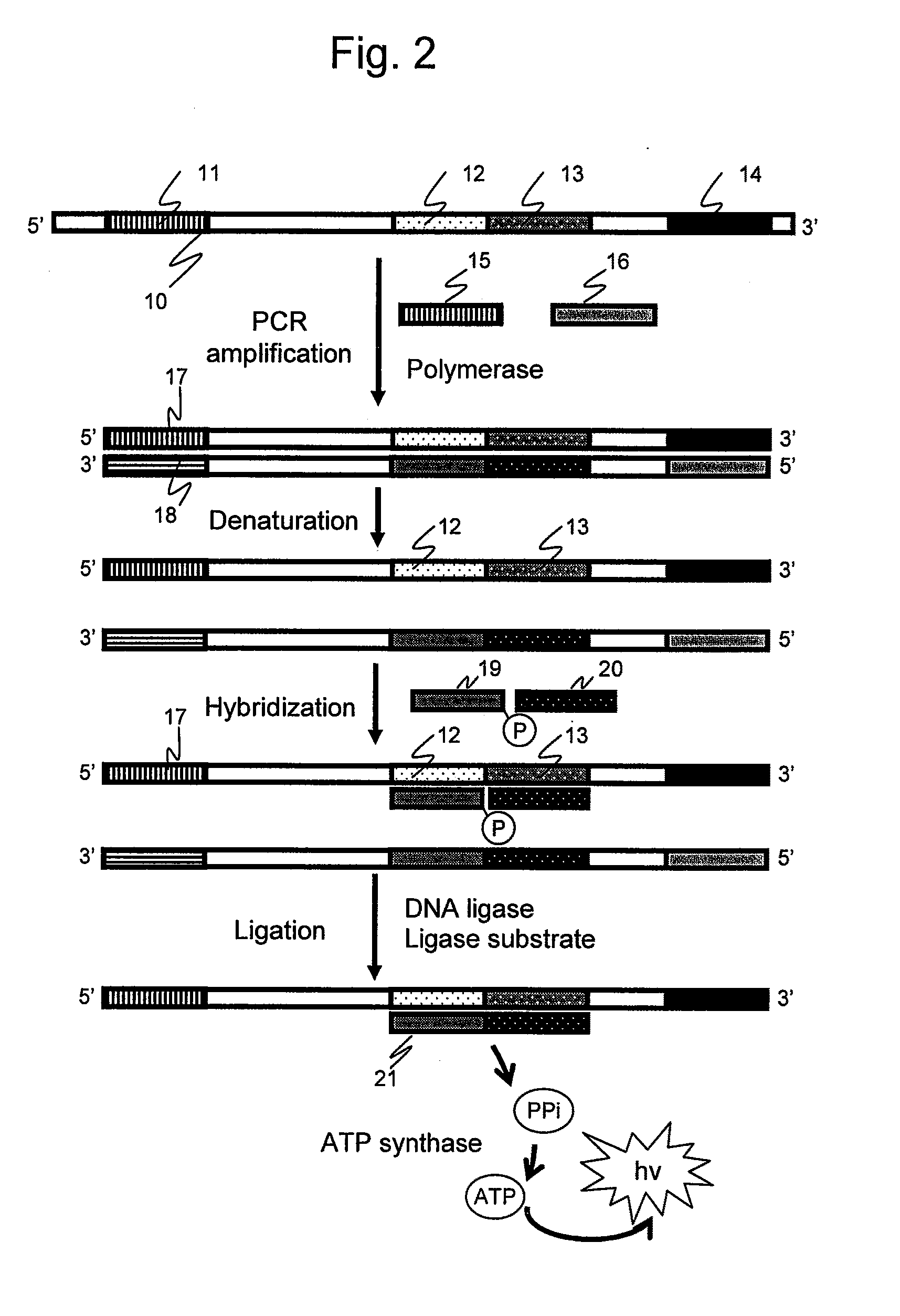Sequence analysis method
a nucleic acid sample and sequence analysis technology, applied in the field of sequence analysis methods for nucleic acid samples, can solve the problems of inability to analyze characteristic nucleotide sequences other than snp, inability to analyze polya lengths at a time, and inability to analyze polya lengths. , to achieve the effect of convenient detection
- Summary
- Abstract
- Description
- Claims
- Application Information
AI Technical Summary
Benefits of technology
Problems solved by technology
Method used
Image
Examples
example 1
[0074]The following synthetic oligo DNAs were used in Example 1:
Nucleic acid sample 1:(SEQ ID NO: 1)5′-CTCTCTCATCAGCGAACCACAACTCAAGACCTCGTTAAGGGAGCGGAGCGGTAATGCTAGTTATTGTCCA-3′Nucleic acid sample 2:(SEQ ID NO: 2)5′-CTCTCTCATCAGCGAACCACAACTCAAGACCTCGTTAAGGGAGCGGAGCG-3′Probe 1:(SEQ ID NO: 3)5′P-CGCTCCGCTCCCTTAACGAG-3′Probe 2:(SEQ ID NO: 4)5′TET-TGGACAATAACTAGCATTAC-3′
[0075]In a first embodiment of the present invention, a reaction product was confirmed by electrophoresis to confirm whether the presence or absence of a nucleic acid sequence in a nucleic acid sample agrees with the presence or absence of a ligation product according to the present method.
[0076]The above-described synthetic oligo DNAs were used as nucleic acid samples and probes. The nucleic acid sample 1 has a 70-nt (nucleotide) sequence. The nucleic acid sample 2 has a 50-nt sequence obtained by deleting at 51 to 70 nucleotide positions from the 5′-end of the nucleic acid sample 1. The probe 1 is a probe of 20 nucleoti...
example 2
[0080]The following synthetic oligo DNAs were used in Example 2:
Nucleic acid sample 1:(SEQ ID NO: 1)5′-CTCTCTCATCAGCGAACCACAACTCAAGACCTCGTTAAGGGAGCGGAGCGGTAATGCTAGTTATTGTCCA-3′Nucleic acid sample 2:(SEQ ID NO: 2)5′-CTCTCTCATCAGCGAACCACAACTCAAGACCTCGTTAAGGGAGCGGAGCG-3′Probe 1:(SEQ ID NO: 3)5′P-CGCTCCGCTCCCTTAACGAG-3′Probe 2:(SEQ ID NO: 4)5′TET-TGGACAATAACTAGCATTAC-3′
[0081]In the first embodiment of the present invention, chemiluminescence attributed to a reaction product was detected to confirm whether the presence or absence of a nucleic acid sequence in a nucleic acid sample can be detected based on chemiluminescence.
[0082]The same nucleic acid samples, probes, and reaction composition as in Example 1 were used. To decrease a background in luminescence detection, a reaction solution was incubated at 40° C. for 1 hour to remove ligation reaction-underived ATP present in the reaction solution using apyrase. Then, the analysis was conducted.
[0083]A reaction flow is shown in FIG. 10. A...
example 3
[0084]The following synthetic oligo DNAs were used in Example 3:
Primer 1:5′-ATCCGGATATAGTTCCTCCTTTCAG-3′(SEQ ID NO: 5)Primer 2:5′-CCATCGCCGCTTCCACTTTTT-3′(SEQ ID NO: 6)Probe 3:5′P-CCAGTAGTAGGTTGAGGCCGTT-3′(SEQ ID NO: 7)Probe 4:5′-GACTCCTGCATTAGGAAGCAGC-3′(SEQ ID NO: 8)
[0085]In a second embodiment of the present invention, chemiluminescence attributed to a reaction product was detected to confirm whether an amplified nucleic acid sample in analysis can be quantitatively detected based on chemiluminescence.
[0086]pET21a vector DNA (TAKARA BIO) prepared in 103 copies and 106 copies was used as nucleic acid samples. The above-described primers were used as oligonucleotide primers for amplification. A nucleotide sequence 105 (SEQ ID NO: 9) of an elongation product is shown in FIG. 12. The primer 1 is a forward primer having the same sequence as the 1st to 25 nucleotide positions from the 5′-end of the nucleotide sequence 105 described in FIG. 12. The primer 2 is a reverse primer having a ...
PUM
| Property | Measurement | Unit |
|---|---|---|
| chemiluminescence | aaaaa | aaaaa |
| chemiluminescence reaction | aaaaa | aaaaa |
| length | aaaaa | aaaaa |
Abstract
Description
Claims
Application Information
 Login to View More
Login to View More - R&D
- Intellectual Property
- Life Sciences
- Materials
- Tech Scout
- Unparalleled Data Quality
- Higher Quality Content
- 60% Fewer Hallucinations
Browse by: Latest US Patents, China's latest patents, Technical Efficacy Thesaurus, Application Domain, Technology Topic, Popular Technical Reports.
© 2025 PatSnap. All rights reserved.Legal|Privacy policy|Modern Slavery Act Transparency Statement|Sitemap|About US| Contact US: help@patsnap.com



